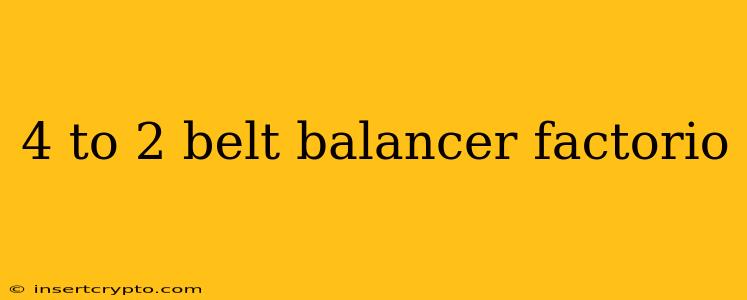Efficient logistics are crucial in Factorio, and belt balancers are key to preventing bottlenecks and maximizing throughput. This guide dives deep into designing and understanding a 4-to-2 belt balancer, a common challenge in mid-to-late game Factorio production. We'll explore different designs, their strengths and weaknesses, and how to integrate them effectively into your factory.
Understanding the Need for Balancers
Before diving into the specifics of a 4-to-2 balancer, let's understand why they're necessary. When you have four input belts feeding into a machine that only accepts two belts, simply merging them will likely lead to uneven distribution and, consequently, inefficient production. A properly designed balancer ensures that items are evenly distributed across the output belts, maximizing the utilization of your production lines.
Common 4 to 2 Belt Balancer Designs
Several effective 4-to-2 belt balancer designs exist, each with its own trade-offs in terms of complexity and space requirements. Here are two popular options:
Design 1: The Simple Split & Merge
This design is straightforward and relatively space-efficient. It involves splitting each of the four input belts into two using splitters, then carefully merging the resulting eight belts into two output belts using more splitters. Careful placement of splitters is critical to ensure even distribution. The weakness of this approach lies in its potential for back-ups if one input belt momentarily experiences a slowdown.
Pros: Simple to understand and build, relatively compact.
Cons: Susceptible to bottlenecks if input flow isn't perfectly balanced. Can be tricky to get perfectly balanced without careful placement and timing of splitters.
Design 2: The Undergrounds and Splitters Approach
This design utilizes underground belts to create a more robust and less visually cluttered balancer. It involves strategically placing underground belts to route items from the input belts to strategically placed splitters feeding the output belts. This method often allows for easier adjustments and troubleshooting.
Pros: More robust against imbalances, cleaner layout, easier to expand upon.
Cons: Requires more underground belts, and thus more resources, can be more complex to understand and build initially.
Optimizing Your 4 to 2 Balancer
Regardless of the design you choose, several factors can impact the efficiency of your 4 to 2 belt balancer:
- Consistent Input: Ensure that all four input belts provide a relatively consistent flow of items. Significant variations in input can overwhelm even the best balancer.
- Splitter Placement: The precise placement of splitters is crucial for even distribution. Experimentation is key to finding the optimal configuration.
- Belt Speed: Utilizing faster belts will increase throughput and reduce the risk of bottlenecks. Consider upgrading to express belts as your factory grows.
- Buffering: Implementing buffers (using chests or storage containers) before and after the balancer can help mitigate the effects of temporary fluctuations in input.
Beyond the 4 to 2: Scaling Up Your Balancing
The principles of a 4 to 2 balancer can be scaled up or adapted for other ratios. Understanding the fundamental concepts of splitting and merging allows you to design and implement more complex balancers to meet your specific factory needs. Remember that properly balancing your belts is key to creating an efficient and scalable Factorio factory.
Conclusion
Building an efficient 4 to 2 belt balancer is a crucial step in optimizing your Factorio production line. By understanding the different designs and factors influencing their performance, you can create a robust and scalable system that keeps your factory running smoothly. Remember to experiment and adapt your designs to suit your specific factory layout and production needs. Happy Factoring!

